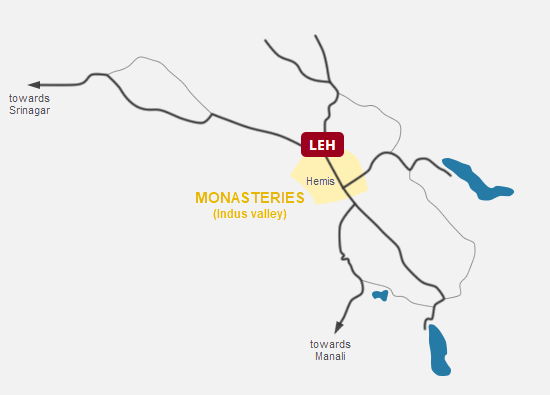

This 1-day Indus valley monastery tour takes you to some of the most famous Buddhist monasteries in Ladakh. This includes Thiksey monastery which resembles the Potala palace in Tibet and Hemis monastery which is the largest gompa in Ladakh. You will visit Shey palace with its 12-metre-high copper statue of Buddha gilded in gold. Stok palace, where the Ladakhi royal family currently lives, has an interesting museum displaying precious royal artefacts and family treasures. You will stop along the Indus river to admire the Stakna monastery built atop a rocky peak. If you drive 20 kilometres more, you could go to Chemrey and visit the beautiful gompa dominating the village and the barley fields.
Choose whether you want to include the visit to Chemrey monastery in your monastery tour in the east part of the Indus valley:
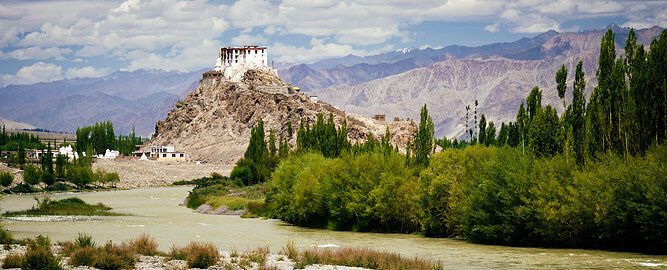
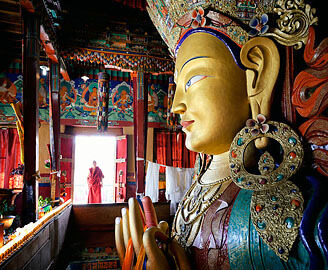
Ladakh is famous for its multitude of secular Buddhist monasteries (or “gompas”) that can be found in almost every village and town. This monastery tour along the Indus river is a day’s trip in the vicinity of Leh. It allows you to cover the major historical and religious sites of the area such as Potala famed Thiksey monastery, Shey monastery-cum-palace, the impressive Hemis gompa, the royal palace of Stok, etc. At the end of the day, this short tour will leave you satisfied, fulfilled of witnessing many monuments and sites, at the same time. Have a read to know what this ‘monastery tour’ has to offer!
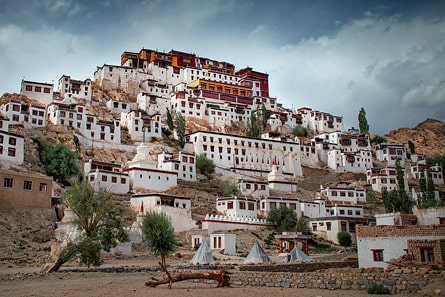
We shall straight dive into the most spectacular monastery around Leh city. Thiksey monastery clings to the side of a hill, resembling a mini version of the renowned Potala Palace of Lhasa in Tibet. In the 15th century, Takpa Bumde, the king of Ladakh, sent a messenger to Galwa Tsongkhapa (the founder of Gelugpa school of Tibetan Buddhism) for a Pontiff for his domain. Assenting to the king’s application, Tsongkhapa assigned the task to Changsem Shesrab Zangpo, one of his six prominent students who established the Dharma in the border areas of Tibet. Consequently, accompanied with many auspicious signs and omens, Thiksey monastery was constructed in mid-15th century under the guidance of Pon Palden Shesrab, a disciple of Changsem Shesrab Zangpo.
Today, being the largest Gelugpa monastery, it houses 80 and more residential monks. They observe their daily and annual rituals of prayers, meditations, festivals and ritual dances as has been the tradition for nearly six hundred years. The monastery has a 14m-high Maitreya Buddha, a temple of twenty-one statue of Goddess Tara, a guardian shrine with veiled deities and dharma protectors in the wrathful form (they are displayed to visitors only during Thiksey Gustor, annual monastic festival), a multipurpose courtyard that serves during monlam (prayers) ceremony, for mask dance performances, and et al, an assembly hall for the daily prayer sessions, and a newly opened library.
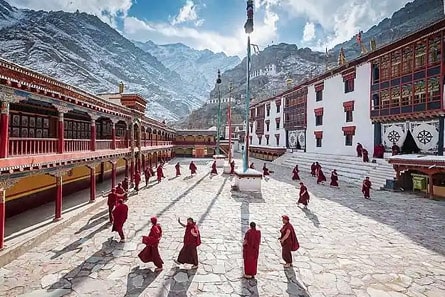
About 43 km from Leh, Hemis monastery is perhaps the largest, the richest and the most well-known monastery within Ladakh. It was founded in the 17th century by Stagsang Raspa Nawang Gyatso of Tibet on the invitation of the King Sengge Namgyal. The monastery belongs to Drukpa Kagyu sect of Tibetan Buddhism. Hemis possesses one of the world’s largest thangka, which they unfurl for public display once in twelve years. Hemis Tsechu (the annual festival) is popular among the locals and tourists. It commemorates the birthday of Guru Padmasambhava, the great Indian master and yogi venerated across Tibet and the Himalayan regions.
The monastery consists of Dukhang (assembly hall) of many kinds, Guardian shrine, a temple room, and an impressive museum. Inside various Dukhang, you can witness remnants of the 17th-century murals, an image of the founder (Lama Stagtsang Raspa), the main statue of Buddha Shakyamuni, Goddess White Tara, and many more. When you enter inside the Guardian shrine, you can see images of Vajradhara, Tilopa, and Naropa (the great masters of Kargyupa tradition) along with Palden Lhamo (Goddess Shri Devi) on a mule, and representations of Mahakala, Tsedak and Kalachakra deities. An impressive 8m-tall image of Guru Padmasambhava sits in the temple room. Around 3 km from the monastery towards the mountains is a sacred hermitage or cave where the great Gyalwang Gotsangpa is believed to have meditated and practised Dharma.
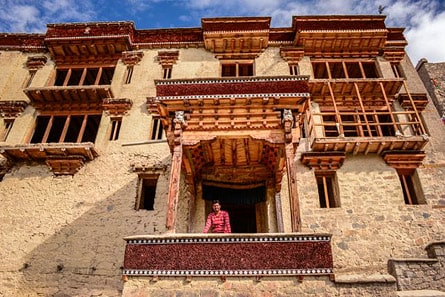
Shey palace is located about 14 km to the east of Leh. The palace-cum-monastery was built in the loving memory of late king Sengge Namgyal by his son king Deldan Namgyal in 1655 AD.
The centre attraction of Shey palace is the 12m copper gilded statue of seated Buddha Shakyamuni (erected as a tribute from the son to his father). The locals visit the Buddha with reverence as it fulfils one's wishes. You should also make a prayer. Who knows it comes true! The ground floor of the temple is the Dukhang (assembly hall) used for prayer ceremonies. Its walls are painted beautifully with frescos depicting different manifestation of Buddha. The main temple is on the second floor, where you could see the Buddha’s peaceful eyes and his charming face. A small shrine to the left-hand side of the main temple is meant for butter lamps. The caretaker monk keeps these lamps lit perpetually. The light offerings are a symbol of diffusing the darkness of ignorance.
Scattered around Shey monastery, you will also notice ruined fortresses and plenty of stupas mostly constructed in the archaic style. The remains of the fort is from the early days of Ladakh as a kingdom, then known as ‘Maryul’. At that time, Shey was the capital of Ladakh when Lachen Palgyigon reigned in the 10th century. You could visit the beautiful and sacred lake in front of the palace.
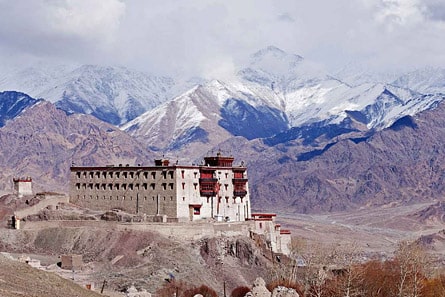
Stok palace is the last addition to the royal palaces of Ladakh as it was built in as late as in the 1820s. Consequently, the Palace is intact, well maintained and still serves the royal progenies of Ladakh.
Located some 16 km from Leh, to the far left bank of the Indus river, the palace was commissioned as a retreating residence for the royalty when the reign of the last king Tsewang Tundup came to an end. After suffering defeat from Zorawar Singh, the general of Dogra king, Ladakh lost its independence to Maharaja Gulab Sing of Jammu. Considered the dark ages, Ladakh remained under Dogras almost a century until the Indian Independence in 1947 when it was made a part of Jammu and Kashmir.
The palace is a four-storied structure. Each floor has a courtyard embellished with intricate woodwork. They keep the royalty entertained and amused by the sight of the village and the scenic Indus valley in all the four seasons. The palace boasts a large number of rooms such as the private royal apartments, kitchen, storeroom, royal shrine, et al. The palace has a beautiful façade and elaborately timber crafts. The museum of Stok Palace displays beautiful, intricate and priceless crowns, dresses and jewellery of the kings and queens of Ladakh.
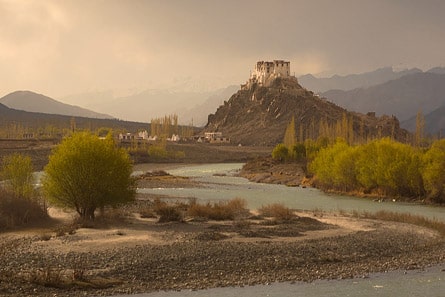
Stakna monastery sits on a hillock to the left of picturesque Indus river, some 23 km from Leh. Stak-na translates into ‘Tiger’s-nose’. The small mound, jutting out of the riverbed, appears like a tiger and its summit where the monastery rests like its nose. Therefore, the monastery is named as ‘Stakna’ or ‘Tiger’s nose’.
Chosje Modzin, a renowned scholar and sage of Bhutan, founded the monastery in the 17th century on the invitation of the king Jamyang Namgyal. To this day, successive reincarnates of the Stakna Tulku heads the monastery. It belongs to the Drukpa Kagyu lineage of Buddhism.
The most important image of the monastery is that of sacred Avalokiteshvara (the lord of compassion) brought from Kamrup in Assam. The monastery consists of Gonkhang (protector shrine in the oldest part of the building), Temples of Lama, the Zimchung (guestrooms for Rinpoches) and the library. Stakna also owns a museum which has a curious collection of arms, armoury and artefacts. Interestingly, there is no tradition of sacred dance in the monastery except for a festival associated with the hurling of votive offerings. The parapets of the monastery provide a complete 360° view of the Indus valley. And, if you happen to be there at the sunset, it adds to the surreal view of the whole expanse of villages, river and forest thickets.
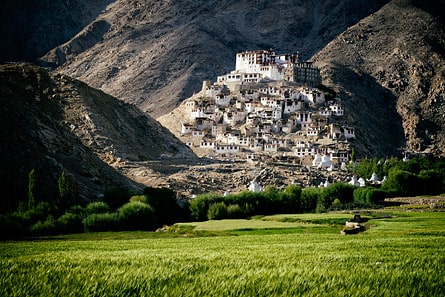
Chemrey monastery was founded three and a half centuries ago by the famed duo of Lama Stagtsang Raspa and his patron the King Sengge Namgyal. Situated at 45 km east of Leh, the monastery overlooks the Chemrey village as it perches on a rocky mound. Like any monastery in Ladakh that belongs to one of the four major Tibetan Buddhism traditions, Chemrey belongs to Drugpa Kagyu. Since its foundation, the recurrent incarnations of Stagtsang Raspa act as its incumbent head lama.
The grand and impressive structure stands tall right in the middle of the lush green village. You would be taken aback upon setting your eyes on the monastery as it appears more of a fortress than a monastery when compared to the humble houses of the sleepy settlement. The monastery comprises of Dukhang (the assembly hall), Guru Lhakhang which houses an ancient image of Guru Padmasambhava, Protector’s chamber, Goddess Tara chamber, Lama Lhakhang and other smaller rooms.
The statue of Padmasambhava is of much veneration for the people of Ladakh. They visit the edifice with their concerns and apprehensions and to find their resolutions. A museum can also be found within the complex. The festival of Chemrey monastery is held every year on the 28th and 29th day of the ninth month of Tibetan lunar calendar. During the festival, monks perform sacred masked dances, initiatory rituals and ceremonies.
The Indus valley is the most accessible place in the entire Ladakh. Therefore, you can visit any time of the year. You will definitely see and feel the different aura of the valley during each season, weather and time. We recommend this package round the year, especially during the monastic festivals.
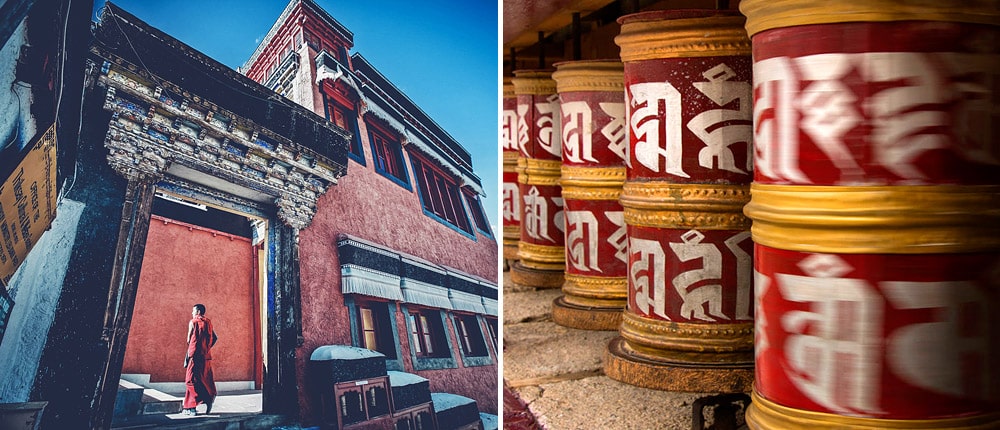
The monasteries of the Indus valley lie at an altitude of more or less 3,500m above sea level, the same elevation as Leh town. Therefore, there is no risk of altitude sickness and the monastery tour can be done at the beginning of the trip in Ladakh, during acclimatization.
There is no need for an Inner Line Permit to visit the monasteries of the Indus valley.
From Leh until Upshi (near Hemis and Chemrey), the phone and internet coverage is reliable. Phone and mobile data services like Airtel, Jio and BSNL work best within the Indus valley. You can also have access to Wi-Fi in hotels, cafes and restaurants in Leh and around.
Many tourists and visitors begin and end their Ladakh tour in Leh. There are plenty of hotels and guesthouses in Leh, for all kinds of budgetary ranges. During this stay in the town, you can spend the time wisely and make most of it by taking a day’s trip to the Indus valley monasteries and sites.
You could also choose to stay nearby the monasteries, villages or along the Indus river. The Indus Valley River Camp located near Shey village has nice cottages at the banks of Indus. Here, you could enjoy the serene evenings along the quiet river while sitting around a campfire. For a traditional taste, you could make your stay at WoodyVu Stok House which is a traditional Ladakhi house turned into a hotel or even experience the unique and historical Stok Palace Heritage Hotel, in Stok palace, and see the 200-year-old murals in the queen’s private room!
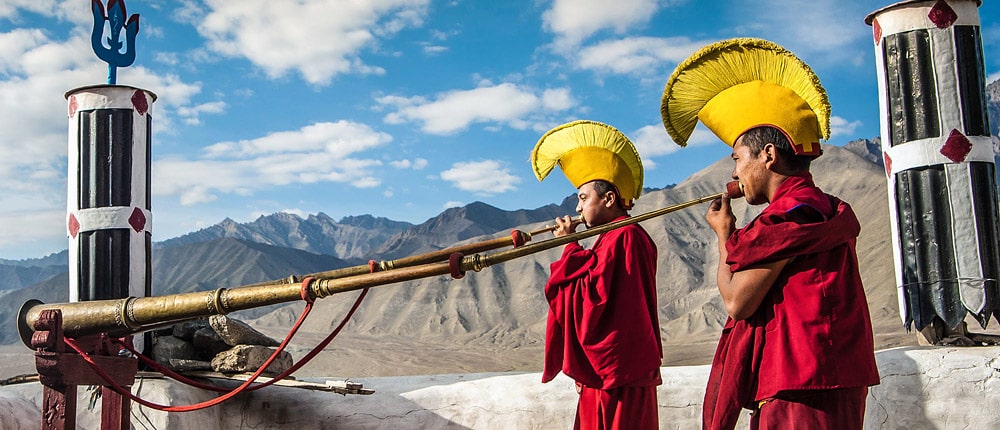
Visit Stok palace, Stakna monastery and Hemis monastery (where you can have lunch). Drive back to Leh and stop at Thiksey monastery and Shey palace on the way.
In the morning, visit Stok palace, Stakna monastery and Hemis monastery. Then, drive to Chemrey monastery. Head back towards Leh and visit Thiksey monastery and Shey palace.
